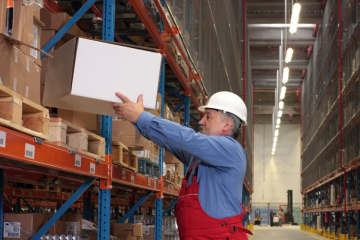Calls for transparency are getting louder. Demand for fast, easy, and reliable access to products is intensifying. Innovation is breeding more competition. And the sustainability challenges we face in the wake of climate change are and will continue to disrupt business operations.
Let’s face it — the pressure to drive business growth in today’s challenging landscape is on.
But the good news? Your supply chain is ripe with opportunity to tackle these challenges whilst creating business value. How? By focusing on supply chain optimization and sustainability.
So, how do you get started? From our perspective, supply chain sustainability is a journey. Below we offer some key steps your organization needs to take — as well as tripping hazards to avoid — as you work to build and manage more sustainable supply chains.
What is Supply Chain Sustainability (SCS)?
Supply chain sustainability (SCS) is a focus within the supply chain management (SCM) sphere whereby an organization’s logistics network or manufacturing process is comprehensively reviewed with the goal of identifying and reducing risk, costs, and environmental impact. SCS can include evaluations of waste output, carbon emissions, water pollution, air pollution, deforestation, and even labor violations.
Traditionally, supply chain efforts have been measured by monetary cost and high-volume production with speedy manufacturing and delivery. As consumers grow more cognizant about the social, economic, and environmental impacts behind their products and services, investors and stakeholders now expect more disclosure around supply chain logistics.
The foundation of supply chain sustainability is the understanding that socially responsible processes are beneficial for all. Consumers can feel good about a product or service, a brand can build positive brand awareness, and a company can minimize its impact while growing profitability.
4 Supply Chain Steps to Take & Missteps to Avoid
1. Make sure your own house is in order
Before you can engage your supply chain partners in sustainability discussions, you need to ensure your owned and operated facilities are walking the sustainability talk. If not, how can you possibly ask your partners and vendors to step up their game?
Chances are, you’ve already tackled optimizing the basics such as regulatory compliance and minimizing water and energy usage and waste. And you may have moved on to more advanced reuse and recycling initiatives. Now, it’s time to take stock of where you are and where you want to be.
If you don’t have the internal resources, a sustainability consulting firm can help you conduct a facility optimization assessment. This will not only help you uncover risks and prioritize opportunities but also provide the data and insights you’ll need to engage your incoming raw materials suppliers and outgoing distribution networks.
Also, keep in mind that supplier facilities share a lot of similarities with your own facilities (e.g., boilers, cooling towards, HVAC), so take advantage of opportunities to share best practices and technical expertise.
The tripping hazard to avoid: When it comes to prioritizing action items at the facility level, don’t try to focus on too many things at once. Start out by putting your investment where you’ll get the biggest return. Once you’ve gained some insight and momentum, you can tackle the more time- and resource-intensive opportunities and develop a consistent set of best practices that can be scaled across your facilities.
2. Map and prioritize your supply chain — with broad and local context in mind
From raw materials to distribution, your supply chain is long and winding — but you need to get your arms around it and prioritize efforts if you want to drive change.
Create a high-level map of your vendor and partner stakeholders at each touchpoint along the supply chain, taking into account the importance of the materials and services provided, the level of relationship and collaboration potential, and their relative sustainability maturity.
In addition, make an effort to understand local sustainability risks, challenges, and opportunities throughout your supply chain. Why? Because operational context matters. Not only will you gain local insights to guide your own initiatives, but this will also help you prioritize who, why, and how you engage vendors moving forward.
The tripping hazard to avoid: Don’t miss the forest for the trees. Set clear objectives around where your biggest opportunities lie so you can target specific, best-fit vendors to engage first and establish momentum.
When it comes to gaining local operational context, leverage available data and tools to identify hot spots where you can make a real difference together. For example, Aqueduct is a robust water risk mapping tool that can help you understand where and how water risks are emerging around the globe.
3. Develop and execute your stakeholder engagement plan
Now that you’ve gained internal and external insight, and prioritized your opportunities, it’s time to start engaging your targeted list of vendors.
Based on your knowledge of your key contacts, choose the most effective way to communicate — email, phone, or an in-person meeting to get the ball rolling. Keep your initial pitch as brief as possible while still conveying all the essential details. And absolutely lead with the “what’s in it for them” piece to avoid the perception of simply being a customer mandate.
If you’re strapped for internal resources or expertise, this is another opportunity to engage an outside consulting partner with stakeholder engagement experience. As an expert in this area, a consultant can provide an objective third-party perspective, as well as leverage their team and other industry contacts to ensure you engage at the right time, in the right way, with the right objectives in place.
The tripping hazard to avoid: Try not to set high-expectations right out the gate. Supply chain engagement is time-consuming — especially in the beginning. In addition, you may discover your vendors don’t have as much influence in the market as you originally thought, the resources to apply to sustainability or even a full understanding of the emerging challenges and expectations that are driving this engagement. So, be realistic, be agile, and know that you won’t be able to control everything.
4. Assess the business value
As you gain momentum with your supply chain partners and initiatives take shape or get launched, it’s important to establish regular checkpoints. This will not only help you ensure you’re able to refine your efforts and continue to drive toward your objectives, but also reinforce the business case.
Have you reduced risk? How have you optimized your business? Have you gained a competitive advantage? Why or why not? Answering these questions on an ongoing basis will help you diagnose where you’re falling down or where you have an opportunity to further invest.
As you embark or continue on your journey, there will be hesitancy throughout your organization and your supply chain. By continually assessing the business value of your efforts, you’ll be able to pivot and bolster your company and your partner’s commitments.
The tripping hazard to avoid: If things are running smoothly, it can be easy to sit back and rest on your laurels. But not so fast. As previously mentioned before, you’re on a journey. And in order to continue to create value, your efforts need to mature. So, stay focused on what you’re doing to keep the momentum going, but also be looking to what should come next.
Start Your Journey to a More Sustainable Supply Chain
There’s no one-size-fits-all approach to enhancing supply chain sustainability — or getting your vendors on board. Each company or industry has a unique set of challenges and priorities. However, the opportunity is undeniably there.
Take the first step by ensuring your organization’s sustainability foundation is strong. Then move on to mapping, prioritizing, and engaging your greatest opportunities for enhancing shared value within your supply chain. Finally, always go back to the business case to keep you moving in the right direction and to lay the groundwork for the next stage of your journey.
Want more news and insights like this?
Sign up for our monthly e-newsletter, The New Leaf. Our goal is to keep you updated, educated and even a bit entertained as it relates to all things EHS and sustainability.
Get e-NewsletterHave any questions?
Contact us to discuss your environment, health, safety and sustainability needs today.





